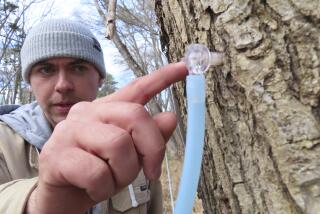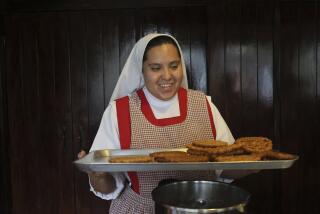Maple Sugaring Spring in Province of Quebec
- Share via
PLESSISVILLE, Canada — Springtime means sugar time in the vast maple forests of southern Quebec Province. It’s party time, too, for when the long Canadian winter has finally run its course and the sap starts flowing in the trees, the table is set for the sweetest celebrations this side of the Big Rock Candy Mountain.
“Sugaring off,” as this annual rite of spring is called, draws thousands of sweet-toothed visitors to the province’s 143 sugarbush farms to witness a miracle of nature and taste the bounties of its maple syrup, taffy and sugar in the rollicking ambiance of woodland cabin parties and elaborate regional festivals.
Quebec’s richest maple country centers on the historic rolling hills in the Beauce and Bois-Franc districts on the southern shore of the St. Lawrence River about 130 miles northeast of Montreal. It’s 40 miles north of the Vermont border and directly across the river from romantic Quebec City.
Plessisville claims to be the world capital of maple production, and attracts as many as 100,000 visitors to its weeklong festival in middle or late April. The program always includes a huge night parade, street dancing, live theater, fireworks, craft and antique sales, traditional French-Canadian cuisine and, of course, all the maple goodies you can eat.
The six-county Pays de l’Erable (Maple Country) embraces some of the best preserved architectural history in the province. Many villages date to the early 17th Century when the first French colonists arrived. Their past is scrupulously maintained in many old churches, houses, farmsteads and covered bridges . . . and in the sweet maple legacy bequeathed by the Indians almost four centuries ago.
But many other maple groves are scattered throughout the province, including the sky country in the Laurentian Mountains north of Montreal and Quebec City, and the south-shore Eastern Townships, where sugar parties meld happily with the warm pleasures of spring skiing.
Sap Season
This spring several towns and farms will host maple festivals. But because it’s impossible to predict when the sap will start running, precise dates cannot be set far in advance.
Depending on the weather, the sugar season usually runs from about March 20 to late April, the period of sub-freezing nights and above-freezing days that the Indians called the “maple moon.” This freeze-thaw alternation generates a flow of sap that is tapped and collected, then boiled into syrup, taffy or sugar.
It is applied in many inventive ways in products eaten either on their own or combined with basic country cooking.
One popular type of get-together is the afternoon rendezvous for taffy making at a timberland sugar cabin, with its own outback boiler house. Maple sap is boiled past the syrup stage into more gelatinous taffy, which is poured hot onto trays of clean snow. The taffy is allowed to thicken a bit more, then wound onto sticks into a maple lollipop.
For more substantial maple cookery, the evening may feature a country supper of pancakes, omelet, ham, Canadian bacon (which Canadians call peameal or back bacon) and baked beans, all prepared in or served with syrup.
Maple Madness
The culinary piece de resistance , though, is the full-course dinner of maple haute cuisine , with anything not cooked in syrup doused in it when served.
For an aperitif, the maple initiate might try a banana-maple daiquiri, or a hot buttered rum using maple syrup in place of honey or sugar. Or for the kids, a chilled, blender-mixed drink combining syrup, salt, milk and vanilla ice cream.
A super-luxe all-maple dinner might begin with an egg poached in boiling syrup, then a green salad dressed with maple syrup vinaigrette.
Crescendoing to the main course, we’re presented with maple-basted ham, chicken, pork or lamb, garnished with baked beans in syrup, maple-glazed carrots and syrup-topped oreilles de crisse , puffy fried fatback.
What to drink with all this is anyone’s choice. Some syrup gourmets suggest extra-sweet wine to harmonize with the sweetness of the food. Others advise offsetting the sweetness with milk, black coffee or clear tea. Many, though, wash it down with that good old Canadian staple, beer.
Dessert presents another nectareous dilemma, with selections of maple mousse, custard, maple meringue apples, maple chiffon or sugar pies, and all description of maple cakes and cookies.
If that’s not a strong enough sugar fix, you might want a digestive of maple liqueur with after-dinner coffee. But if it all sounds too much, all cabins offer many non-maple dishes for the faint of heart and tooth. They include Quebecois specialties such as split pea soup, pig’s feet stew and tourtiere , a spicy meat pie of ground beef and pork.
Sugar-Party Time
The woodsy, homey atmosphere at a sugar party is almost an event. Most of the cabins are in the sugarbush (sugar maple grove), often near streams with the water cracking through the ice in the spring break-up, and with the rich smell of the reawakening earth rising through the melting snow.
The cabins, which range in capacity from 20 to 650 diners, are sylvan and rustic inside and out, with a boardinghouse style of meal service at long tables, engendering an easy, friendly spirit that draws everyone into the fun.
One of the finest in Quebec is the Sucrerie de la Montagne, on a hilltop near the town of Rigaud about 40 miles west of Montreal. Owner Pierre Faucher and his wife, Sandra, an emigre from Oregon, can seat up to 450 people in their dining halls that also feature Quebec folk entertainment and dancing.
Faucher, who has cooked his maple specialties at major food fairs in France, adheres strictly to the traditional methods of his craft. His 40-acre sugarbush contains a century-old barn built of pine logs that is now the dining hall. The Fauchers bake breads in their bakery and prepare ham in their smokehouse. Winding through the trees are 28 miles of cross-country skiing and snowshoeing trails.
A sugar party often climaxes a day’s skiing at this time of year, when those cold nights and warm days transform the trail surfaces into the easy-skiing corn snow every Eastern skier loves. Quebec’s ski season usually lasts until late April, with some resorts, notably the Laurentians’ Gray Rocks Inn and Mont Ste. Anne near Quebec City, almost always continuing into May.
Pioneer Method
An afternoon at a sugar cabin usually includes a demonstration of how maple products are made. The pioneer method, which dates back more than 200 years, begins with tapping the trees by driving wooden spigots into the trunks, channeling the sap into pails suspended below.
The full pails are emptied into wooden barrels and carried by horse-drawn sleighs to the boiler house, where the sap is boiled in huge iron kettles. It takes about 40 gallons of sap to make one gallon of syrup, which may be boiled further into taffy, or further still until the only residue is maple sugar, which is fashioned into fudge or fancy candies.
Maple products have become a big business, with Quebec producing 60% of the world’s annual output of about 50 million pounds. The rest of Eastern Canada contributes another 10%, and the far northeastern United States 30%.
In the large commercial sugarbushes, with up to 20,000 trees, horses have been replaced by snowmobiles and, more recently, networks of plastic tubing carry the sap directly from the trees to evaporator plants.
But even as the industry modernizes, the traditional sugar house and family operation, so evocative of Canada’s pioneer past, is still going strong, and sugaring off should firmly endure as a joyful Quebec tradition. In a country whose national symbol is the maple leaf, how could it fail to?
Information: Quebec Government Tourist Office, 700 S. Flower St., Suite 1520, Los Angeles 90017, phone (213) 689-4861.
More to Read
Sign up for The Wild
We’ll help you find the best places to hike, bike and run, as well as the perfect silent spots for meditation and yoga.
You may occasionally receive promotional content from the Los Angeles Times.






